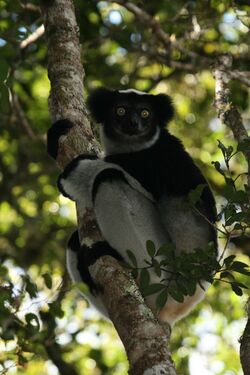Indri indri (Indri): Difference between revisions
imported>Kim van der Linde (added taxobox) |
mNo edit summary |
||
| (5 intermediate revisions by 3 users not shown) | |||
| Line 9: | Line 9: | ||
| image = Indri6.jpg | | image = Indri6.jpg | ||
| image_width = 250px | | image_width = 250px | ||
| image_caption = A '''Indri''', (''Indri indri''). | | image_caption = A '''Indri''', (''Indri indri''). | ||
| regnum = [[Animal]]ia | | regnum = [[Animal]]ia | ||
| phylum = [[Chordata]] | | phylum = [[Chordata]] | ||
| Line 21: | Line 21: | ||
| binomial_authority = ([[Johann Friedrich Gmelin|Gmelin]], 1788) | | binomial_authority = ([[Johann Friedrich Gmelin|Gmelin]], 1788) | ||
}} | }} | ||
The ''' | The '''indri''' ''Indri indri'' is the largest living [[lemur]]. In the wild, it is found only on the island of [[Madagascar]]. | ||
==Description== | ==Description== | ||
The indri is a diurnal [[ | The indri is a diurnal [[primate]] that has a head body length of approximately 64 – 72 cm and a stubby vestigal tail <ref name="Fleagle">{{cite book|title=Primate Adaptation and Evolution|accessdate=|author=J. Fleagle|authorlink= |coauthors= |date=1998 |format= |work= |publisher=Academic Press: New York|pages= |language= |archiveurl= |archivedate= |quote= }}</ref><ref name="Szalay">{{cite book |title=Evolutionary History of the Primates|accessdate=|author=F. Szalay and E. Delson|authorlink= |coauthors= |date=2001 |format= |work= |publisher=Academic Press, New York|pages= |language= |archiveurl= |archivedate= |quote= }}</ref><ref name="Mittermeier">{{cite book|title=Lemurs of Madagascar|accessdate=|author=Mittermeier et al.|authorlink= |coauthors= |date=2006 |format= |work= |publisher=Conservation International|pages= |language= |archiveurl= |archivedate= |quote= }}</ref>. Weight ranges between approximately 6kg up to almost 10kg <ref name= "Mittermeier"/>. Coat color varies from predominantly black contrasting with a white pygal patch and paler facial ring, to variegated black and white<ref name= "Mittermeier"/>. Males can be difficult to distinguish from females, but in the [[Analamazaortra Special Reserve]] males are slightly larger than females and there is slight [[sexual dimorphism|dimorphism]] in color pattern<ref name= "Mittermeier"/>. | ||
==Behaviour== | ==Behaviour== | ||
The indri lives in small family groups<ref name="Szalay"/>. Its movement is described as vertical climbing and leaping and it maintains a preferential upright body posture<ref name= "Mittermeier"/>. The indri has a loud vocalization which has been described as an “eerie wailing song” <ref name= "Mittermeier"/>which can be reminiscent of the singing of some whale species. | The indri lives in small family groups<ref name="Szalay"/>. Its movement is described as vertical climbing and leaping and it maintains a preferential upright body posture<ref name= "Mittermeier"/>. The indri has a loud vocalization which has been described as an “eerie wailing song” <ref name= "Mittermeier"/>which can be reminiscent of the singing of some whale species. | ||
{{Image|Indri2.jpg|left|200px|A indri climbing between trees. Note the stub of a tail. The indri is the only "tailess" lemur <ref name= "Mittermeier"/>.}} | |||
==Diet== | ==Diet== | ||
| Line 42: | Line 42: | ||
==References== | ==References== | ||
{{reflist}} | {{reflist}}[[Category:Suggestion Bot Tag]] | ||
Latest revision as of 06:00, 1 September 2024
| Indri | ||||||||||||||
|---|---|---|---|---|---|---|---|---|---|---|---|---|---|---|
 A Indri, (Indri indri).
| ||||||||||||||
| Conservation status | ||||||||||||||
| Scientific classification | ||||||||||||||
| ||||||||||||||
| Binomial name | ||||||||||||||
| Indri indri (Gmelin, 1788) |
The indri Indri indri is the largest living lemur. In the wild, it is found only on the island of Madagascar.
Description
The indri is a diurnal primate that has a head body length of approximately 64 – 72 cm and a stubby vestigal tail [2][3][4]. Weight ranges between approximately 6kg up to almost 10kg [4]. Coat color varies from predominantly black contrasting with a white pygal patch and paler facial ring, to variegated black and white[4]. Males can be difficult to distinguish from females, but in the Analamazaortra Special Reserve males are slightly larger than females and there is slight dimorphism in color pattern[4].
Behaviour
The indri lives in small family groups[3]. Its movement is described as vertical climbing and leaping and it maintains a preferential upright body posture[4]. The indri has a loud vocalization which has been described as an “eerie wailing song” [4]which can be reminiscent of the singing of some whale species.

Diet
The indri is predominantly a folivore that eats mainly immature leaves, but it also feeds on seeds, fruits and flowers[3][4].
Geographical distribution
The indri may be found in tropical moist lowlands and montane forests of eastern Madagascar[4].
References
- ↑ Ganzhorn et al (2000). Indri indri. 2006 IUCN Red List of Threatened Species. IUCN 2006. Retrieved on 11 May 2006. Listed as Endangered (EN A1c+2c v2.3)
- ↑ J. Fleagle (1998). Primate Adaptation and Evolution. Academic Press: New York.
- ↑ 3.0 3.1 3.2 F. Szalay and E. Delson (2001). Evolutionary History of the Primates. Academic Press, New York.
- ↑ 4.0 4.1 4.2 4.3 4.4 4.5 4.6 4.7 4.8 Mittermeier et al. (2006). Lemurs of Madagascar. Conservation International.
